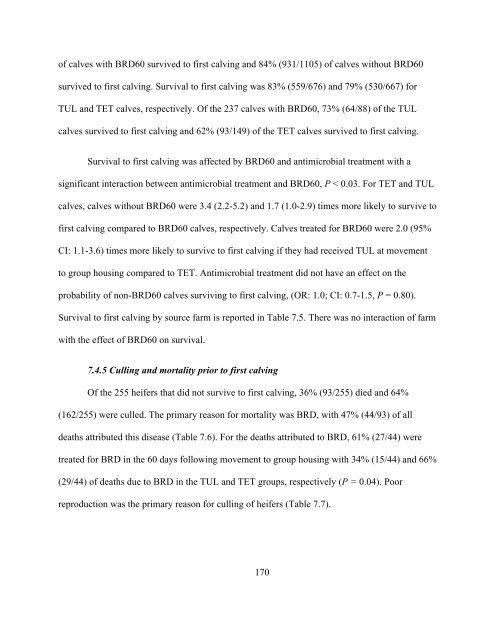Stanton PhD Thesis final_docx - Atrium - University of Guelph
Stanton PhD Thesis final_docx - Atrium - University of Guelph
Stanton PhD Thesis final_docx - Atrium - University of Guelph
You also want an ePaper? Increase the reach of your titles
YUMPU automatically turns print PDFs into web optimized ePapers that Google loves.
<strong>of</strong> calves with BRD60 survived to first calving and 84% (931/1105) <strong>of</strong> calves without BRD60<br />
survived to first calving. Survival to first calving was 83% (559/676) and 79% (530/667) for<br />
TUL and TET calves, respectively. Of the 237 calves with BRD60, 73% (64/88) <strong>of</strong> the TUL<br />
calves survived to first calving and 62% (93/149) <strong>of</strong> the TET calves survived to first calving.<br />
Survival to first calving was affected by BRD60 and antimicrobial treatment with a<br />
significant interaction between antimicrobial treatment and BRD60, P < 0.03. For TET and TUL<br />
calves, calves without BRD60 were 3.4 (2.2-5.2) and 1.7 (1.0-2.9) times more likely to survive to<br />
first calving compared to BRD60 calves, respectively. Calves treated for BRD60 were 2.0 (95%<br />
CI: 1.1-3.6) times more likely to survive to first calving if they had received TUL at movement<br />
to group housing compared to TET. Antimicrobial treatment did not have an effect on the<br />
probability <strong>of</strong> non-BRD60 calves surviving to first calving, (OR: 1.0; CI: 0.7-1.5, P = 0.80).<br />
Survival to first calving by source farm is reported in Table 7.5. There was no interaction <strong>of</strong> farm<br />
with the effect <strong>of</strong> BRD60 on survival.<br />
7.4.5 Culling and mortality prior to first calving<br />
Of the 255 heifers that did not survive to first calving, 36% (93/255) died and 64%<br />
(162/255) were culled. The primary reason for mortality was BRD, with 47% (44/93) <strong>of</strong> all<br />
deaths attributed this disease (Table 7.6). For the deaths attributed to BRD, 61% (27/44) were<br />
treated for BRD in the 60 days following movement to group housing with 34% (15/44) and 66%<br />
(29/44) <strong>of</strong> deaths due to BRD in the TUL and TET groups, respectively (P = 0.04). Poor<br />
reproduction was the primary reason for culling <strong>of</strong> heifers (Table 7.7).<br />
170

















